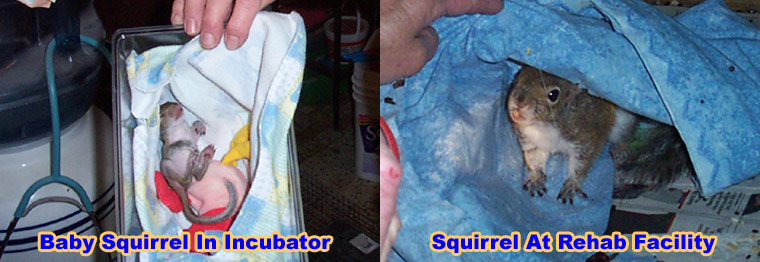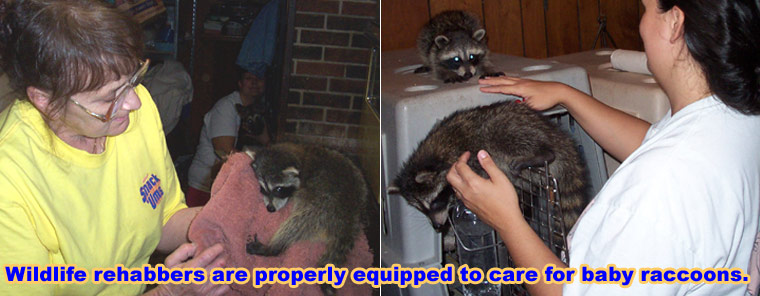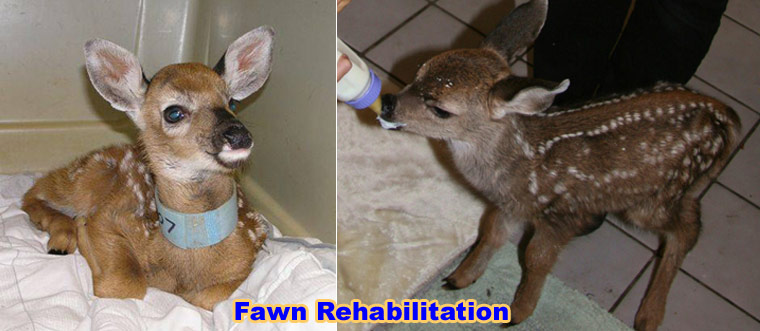-
info@aaanimalcontrol.com
Call us for help in your town
Humane Wildlife Education
DIY wildlife rehabilitation
Need wildlife removal in your hometown? We service over 500 USA locations! Click here to hire us in your town and check prices - updated for year 2020.
Does this animal need your help?
In spring and summer our chances for contact with wild animals increase. Wild babies get into problem situations as they explore their world. Before assuming that a baby or juvenile animal needs our help, please consider that it may simply be learning survival skills, with a parent nearby. Many times baby animals and birds ARE orphaned, but please be certain the animal needs your help before you intervene.
Fall and winter are difficult times for many animals. We see more migratory bird species that get into trouble on their travels through unfamiliar territory. Mammals and birds that do not migrate are feeding heavily to prepare themselves for the long cold nights ahead. They must store or locate food sources that will sustain them through the winter months, and many must find new territories as the adults in their area force them to move.
To locate a wildlife rehabilitator in your area go to www.wildliferehabber.com. and you can discuss the situation to be certain you should assist.

BABY BUNNIES: Baby bunnies in their nest are often uncovered when people do yardwork. The mother feeds her babies twice a day - at dawn and at dusk and is probably nearby watching you. If you have uncovered a nest of baby bunnies, you can put the nest back together as it appeared when you found it. Your scent may attract predators, but it will NOT discourage the mother from attending her babies. To determine if the mother is returning, arrange sticks over the grass-covered nest in a tic-tac-toe pattern. If the sticks have not been moved after 24 hours (two feedings), contact a wildlife rehabilitator. Preserve and bring as much of the nest as you can if you transport the bunnies to a wildlife rehabilitator as this will reduce the stress of the babies.
Do not attempt to feed them yourself. Baby bunnies can easily survive one day without feeding, but can die with too much handling or if they are fed cow's milk and NEVER feed a cold animal as it will KILL the animal.
BABY SQUIRRELS: Baby squirrels may be found on the ground if crows or other predators have attacked the nest. Baby squirrels will also emerge from their nests if their mother has been killed. If this has happened, you may hear a high-pitched squeaking from the nest or you may find one or two of the babies that have crawled out on their own. There may be others who will not leave the nest. Baby squirrels may also be found if the mother squirrel has made her nest in part of your home or other structure (cars, sheds, air conditioners) or if you have trimmed a tree with a nest inside. The mother will retrieve her babies and move them to an alternate nest if you keep the babies safe, warm and in a place that is accessible for her. Keep all children and pets away from the area and give the mother time to move them. If the babies have been injured or appear starving and dehydrated or you KNOW they have been orphaned they should be brought to a wildlife rehabilitator for care. If the mother has not returned to re-home her babies within a few hours, contact a wildlife rehabilitator. Do NOT leave baby squirrels outside overnight. Keep them in a warm, quiet, dark place (a shoebox lined with a t-shirt and placed half on and half off a heating pad set to Low works well) until transported to a rehabilitator. You can KILL an animal with kindness. Please DO NOT feed cold babies as animals must be warmed and hydrated before they are fed. Do NOT feed cow's milk as squirrels and other wildlife do not tolerate lactose and may die from the intestinal problems that result.
If a juvenile squirrel approaches you, the animal should be carefully captured (wear gloves to prevent bites from the squirrel and/or fleas) and brought to a wildlife rehabilitator. Normally squirrels stay with their mothers until they are able to locate their own food and shelter. Sometimes the squirrels are not ready to be on their own and need some extra assistance. A wildlife rehabilitator will place the juvenile with similar sized squirrels and release them together as a group for additional support.
To discourage squirrels from nesting in attics and eaves, keep your buildings in good repair. Squirrels and other animals look for safe shelter to raise their families. If you have a squirrel family in one of your buildings you can use a radio with the volume turned up and light the area 24-hours a day and/or use rags soaked in commercial rodent repellents (Ropel or coyote urine) to encourage the mother to move. Do NOT seal her entrance until you are certain all members of the family are gone, else the mother will chew another hole to get to her babies. Once you are certain all have moved on, seal the entrance with 1/2" hardware cloth and repair the building to prevent re-entry.

BABY BIRDS: If you find a baby bird with few or no feathers on the ground and it appears healthy, warm the bird in your hands and check to see if you can find the nest. If you can easily replace the bird in the nest, do so after it has been warmed thoroughly. Birds do not have a good sense of smell, and your scent will not be apparent to the parent birds. If the natural nest is too high, or has been destroyed, you can craft a nest out of a basket, margarine tub with holes poked in the bottom, or even a plastic flower pot, lined with leaves and grass and attached as high as possible to a nearby tree. Do not use dryer lint or paper which can become soggy and chill the bird(s). Monitor for a couple of hours, staying out of sight, to ensure the parents have returned and are feeding the baby.
If the bird is fully feathered and is not injured, but cannot fly or cannot fly very far, you can monitor to see if the parents are feeding it. It is common for fledglings to spend some time on the ground before they gain strength to fly normally. If one or both parents are feeding the bird, you can help by keeping children and pets away from the area. You should not pick up the bird for care until you have discussed the situation with a wildlife rehabilitator.
Do NOT feed the babies as they require special handling and can drown if you give them water or other liquids.
BABY RACCOONS: In spring, a raccoon in your fireplace chimney, attic or garage usually means babies are there also. DO NOT START A FIRE to get them to move as the animals will be injured or die of smoke inhalation. Instead, you can encourage the family to move by placing a radio in the fireplace (tuned to a talk radio station with a strong signal) with the volume turned as loud as you can stand. Keep the damper closed. Leave the radio on 24-hours for as long as 72 hours to allow the mother time to relocate the babies.
Do NOT trap in spring and summer as you may be leaving babies behind.
Once you are certain all babies have been moved, cap the chimney, or repair the hole that allowed access. If you are certain the babies have been orphaned, then contact a wildlife rehabilitator for assistance.
Although raccoons are normally nocturnal animals, when a mother has babies to feed, she may need to forage during the day. If you observe a raccoon active during the day, she may simply be taking a break from her mothering to find food. Contact a wildlife rehabilitator for advice if you think the raccoon needs assistance.
If the babies have been injured or appear starving and dehydrated or you KNOW they have been orphaned they should be brought to a wildlife rehabilitator for care. If the mother has not returned to re-home her babies within a few hours, contact a wildlife rehabilitator. Do NOT leave baby raccoons outside overnight. Keep them in a warm, quiet, dark place (a shoebox lined with a t-shirt and placed half on and half off a heating pad set to Low works well) until transported to a rehabilitator. You can KILL an animal with kindness. Please DO NOT feed cold babies as animals must be warmed and hydrated before they are fed. Do NOT feed cow's milk as raccoons and other wildlife do not tolerate lactose and may die from the intestinal problems that result.

BABY RAPTORS: Kind-hearted people commonly find young raptors (hawks, owls, falcons, eagles) out of their nest before they can fly or fly well. Many times these birds have parents who are caring for them and should be left alone.
Occasionally, one of these young raptors is need of help. If a young raptor is out of its nest and is still covered with white downy feathers or acts weak (non-responsive, eyes half-closed) or injured, it may need help. Contact a wildlife rehabilitator for advice and assistance.
BABY DUCKS and BABY GEESE: Ducklings or goslings without a mother and/or father monitoring it need your help. Do not put ducks with another duck family as the mother may kill the orphan. Goslings may be accepted by another family of geese, but you must monitor to be sure the gosling is not ignored, and it should be put with a family that has goslings of similar age or younger than the orphan. You can contact a wildlife rehabilitator for assistance in these cases. Some ducklings can die of stress so keep children and pets away from the ducklings and do not handle them more than to put them in a box lined with a soft, non-ravelling cloth with a covered hot water bottle for warmth.
Once a goose or duck is nesting, the nest and eggs cannot be disturbed. The mother will not tolerate having her nest moved, and it is against federal law to tamper with the nest, eggs or adults. The nesting phase lasts about 30 days and then the family will move on.
If you observe birds or waterfowl nests being disturbed or harassed, the incident should be reported to U.S. Fish and Wildlife Enforcement or state wildlife agencies. It is also illegal to possess bird nests, eggs or feathers without a federal permit.
FAWNS: It is common for a doe to leave her fawn in a protected area so that it appears to well-meaning people as if the fawn has been abandoned. Fawns do not have a scent and are camouflaged with their speckled fur, and so are protected from predation as the mother moves away to feed. If you find a fawn that appears abandoned, do not move or approach the animal until you discuss the situation with a
wildlife rehabilitator. Handling the fawn may leave your scent which will attract predators. If the mother does not return within 24-hours the fawn will need assistance, but you must be CERTAIN that the mother has not returned. She will not approach her baby if people or pets are nearby.

BABY OPOSSUM: Baby opossum are rarely found separate from their mothers. They are North America's only marsupials and hang on to their mothers after they emerge from the pouch. Occasionally one will be separated from the family as the mother is transient and moves from place to place to locate food and to teach her babies to forage. If you find a single baby or juvenile opossum you should contact a wildlife rehabilitator for advice and assistance.
If a mother has been killed (by a car, for instance) you may be able to assist the babies by contacting a wildlife rehabilitator. Do not remove babies from the mother's pouch. Be aware that opossums can 'play dead' and the mother may revive during transport
Opossum play an important role in keeping the environment clean by scavenging and eating rodents. If you leave food outside for your pets, or maintain a compost heap, you may find that attracts wild visitors. While opossum are not aggressive animals, if you do not want opossum in your area, you should keep pet food inside and remove or cover compost.
To locate a wildlife rehabilitator in your area go to www.wildliferehabber.com
(This information compiled from various sources including Wildlife Rehabilitation and Release, Inc., Crystal, Minnesota, Minnesota Wildlife Assistance Cooperative, St. Cloud, Minnesota and Humane Society of the United States).


















